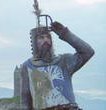stubby331
Posts: 268
Joined: 10/24/2001
From: Perth, Western Australia
Status: offline

|
Found some great excerpts from published works which outline the sort of effort required to supply Darwin WITHOUT A DIRECT RAIL CONNECTION from Alice springs. As discussed, the AHISTORICAL rail link just makes it too easy.
Excerpt from "Outback Corridor":
When a train arrived at Alice Springs from the south all troops and Allied Works Council workers going north by Army convoy were taken to the Staging Camp for an overnight stay before proceeding on next day. The contents of freight trains were off-loaded onto army transports (in the early days 3 ton trucks - Chevrolets, D3 Internationals, later semi-trailers and from 1944 on to Mack-Lanover 10 ton diesels and trailers) for movement north. Normally two platoons of 30 vehicles cleared a freight train load, depending on the vehicle used and type of freight. When the vehicles were loaded they returned to their Army Transport unit lines and parked overnight ready for departure next morning. The train, having been cleared, returned south to Terowie to receive another trans-shipment of supplies and equipment.
Excerpt from "Convoys Up The Track":
Every day three convoys, usually of thirty vehicles, left Alice Springs at forty five minute intervals from 0600 hrs to travel north. Daily, six convoys left the staging camps at Barrow Creek, Banka Banka, Elliot and Larrimah, northward or southward bound. The normal return journey took eight days. The actual turn around time was eleven days, the extra three days being spent in Alice Springs for unloading, vehicle maintenance, military training, washing clothes, collection of pay and reloading for the next convoy.
Excerpt from "An Australian Adventure":
During its four years of operation this unit [Darwin Overland Maintenance Force] increased to 8,000 men and over 3,000 vehicles of every shape and size. Once Alice had her teeth into this war business she certainly pulled no punches. In those four years her convoys covered 82,612,196 miles. They transported from her bulk stores 487,197 tons of war materials and supplies. Apart from the unit personnel, her trucks carried 194,852 persons of all ranks. Naturally such colossal transportation was costly. There were 22,427 tyres used to keep this vital life-line going. To keep those trucks moving, Alice poured into their tanks 8,724,270 gallons of petrol and 350,473 gallons of diesel fuel. Under the bonnets went 197,232 gallons of engine and transmission oil and through the grease guns went 77,690 pounds of grease.
Excerpt from "An Australian Adventure":
She [Alice Springs] not only had to transport men, but she had to feed them, provide water for them, install electric light for them, entertain them, and do a host of other things. I know she was blamed for some things she provided, such as flies, mosquitoes, dust, and bog-holes. Some grumbled about cold or her heat, but all admit she certainly gave them the whole works.
In order that Alice would have an adequate water supply to meet any eventuality, forty one bores and five wells were put down in the town area. Local piggeries produced 55,304 pounds of pork, and gardens grew 380,924 pounds of vegetables.
...
The citizens of Alice Springs played a great part through their various social activities and organisations. In June 1941 Griffiths House, which was originally planned as a children's hostel, was opened as a soldiers' and servicemen's club. It continued in this role until the end of the war. Over a million cups of tea were handed out and over half a million postage stamps were sold for letters written on the premises. Other churches also opened their buildings to cater for the boys.
|
 Printable Version
Printable Version



















 New Messages
New Messages No New Messages
No New Messages Hot Topic w/ New Messages
Hot Topic w/ New Messages Hot Topic w/o New Messages
Hot Topic w/o New Messages Locked w/ New Messages
Locked w/ New Messages Locked w/o New Messages
Locked w/o New Messages Post New Thread
Post New Thread